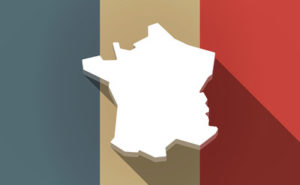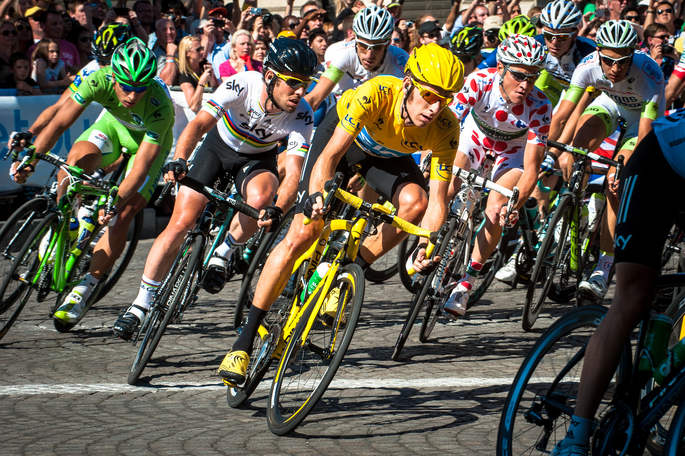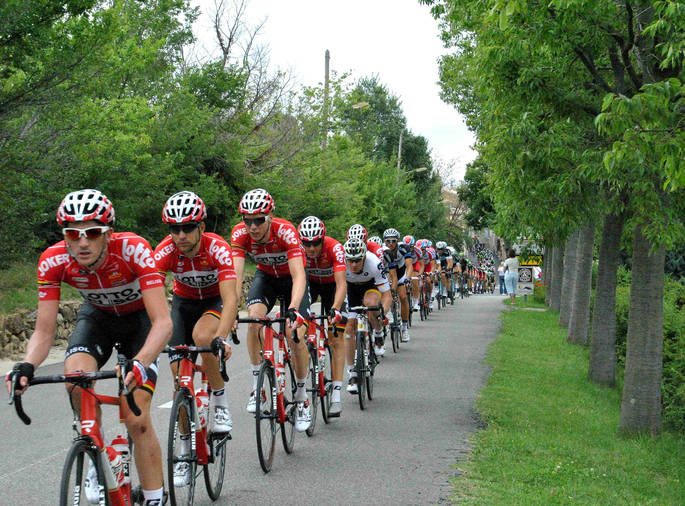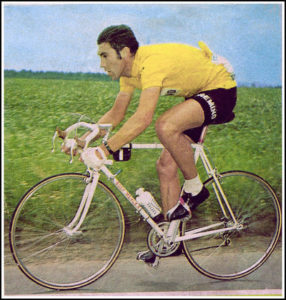 Everyone knows that, when it comes to the Tour de France, the riders are all chasing the yellow jersey. That means that they’ve got the lead and if they cling on to it then they’ll win the race overall. Yet there are also a number of other jerseys that can be picked up as the race goes on, with riders able to host more than one at the same time.
Everyone knows that, when it comes to the Tour de France, the riders are all chasing the yellow jersey. That means that they’ve got the lead and if they cling on to it then they’ll win the race overall. Yet there are also a number of other jerseys that can be picked up as the race goes on, with riders able to host more than one at the same time.
There is, of course, a difference between holding a jersey whilst the Tour is underway and being in possession of a jersey or two when the Tour has reached its conclusion. The former is more common than the latter, though both have happened fairly regularly since the Tour first began back in 1903, as we’ll explain on this page.
The Jerseys Explained

By Josh Hallett, flickr
There are a number of different classifications in the Tour de France, with jerseys to match. The most famous of these is the general classification, which is what the yellow jersey represents and the winner of the classification at the end of the Tour is the person who is said to have won the race overall.
Because riders would neither want nor be able to wear several jerseys at the same time, if they win more than one during a stage of the race then they wear the jersey of the classification that is thought to be the more prestigious. This inevitably means that a winner of numerous classifications including the general one will wear the yellow jersey.
Here’s a look at the various classifications in the Tour de France, complete with an explanation of what they are and what coloured jersey accompanies them.
General Classification – Yellow Jersey
![]() Easily the Tour de France’s most prestigious classification, the general classification is awarded to the leader of the race at the end of each stage. The rider then wears the yellow jersey for the next stage of the race, which was officially introduced in 1919. Prior to the introduction of the yellow jersey, the leading rider would wear a green band.
Easily the Tour de France’s most prestigious classification, the general classification is awarded to the leader of the race at the end of each stage. The rider then wears the yellow jersey for the next stage of the race, which was officially introduced in 1919. Prior to the introduction of the yellow jersey, the leading rider would wear a green band.
The time that each rider takes to complete a stage is added together to give a clear indication of which rider is leading overall. That is to say, a rider could lose an individual stage but still be the overall leader because of the total time taken to do prior stages. This also allows time to be added or subtracted if they get a bonus or a penalty.
In the early years of the tour, there could often be co-leaders because their times were noted in minutes rather than seconds. In such an instance, all the co-leaders would wear yellow for the next stage. In 1967 a short time trial was introduced to the Tour, which could then be used to separate out co-leaders if it were necessary to do so.
There can sometimes be stages in which there is no yellow jersey. It is traditional for the winner of the previous year’s Tour be given the choice to wear it for the first stage of the Tour, but not all do so. It’s also common for riders to refuse to wear the jersey if they have been awarded it because of the misfortune of another rider, such as a crash.
Mountains Classification – Polka Dots Jersey
![]() The Tour de France’s secondary classification was introduced in 1933 and is awarded to the rider that gains the most points by reaching mountain summits before anyone else. The leader is named the King Of The Mountains and gets to wear a white jersey with red polka dots all over it.
The Tour de France’s secondary classification was introduced in 1933 and is awarded to the rider that gains the most points by reaching mountain summits before anyone else. The leader is named the King Of The Mountains and gets to wear a white jersey with red polka dots all over it.
l’Auto, the organising newspaper of the Tour, has named a ‘meilleur grimpeur’, or ‘best climber’ since 1905, but it wasn’t until Henri Desgrange decided in 1933 that cyclists should gain a reward for being such good climbers. That’s thy time bonuses were introduced, with the distance between the first and second cyclist to reach the top given as such.
Though the time bonus was later removed, the King Of The Mountain status remained, with the polka dot jersey introduced in 1975. The decision regarding the colour of the jersey was left to Chocolat Poulain, who sponsored the race at the time and sold chocolate with polka dot wrappers, with the Tour sticking with that ever since.
Points are awarded to the riders for their mountain climbing expertise. If two riders have the same number of points then the rider with the most first place finishes in the hors catégorie cols, or uncategorised, is the classification winner. It is not a classification without criticism, largely that it is often won by cyclists who can break away from the others because they have no hope of winning the general classification.
Points Classification – Green Jersey
![]() Starting in 1953, the points classification is considered to be a secondary competition in the Tour. Points are awarded to riders for high finishes in a stage as well as for winning the intermediate sprints. Generally speaking, it is thought of as being a sprinter’s competition, with the rider with the most points wearing the green jersey.
Starting in 1953, the points classification is considered to be a secondary competition in the Tour. Points are awarded to riders for high finishes in a stage as well as for winning the intermediate sprints. Generally speaking, it is thought of as being a sprinter’s competition, with the rider with the most points wearing the green jersey.
Cyclists first began receiving points in the Tour de France in 1905, which came about because of scandals the year before. It was changed back to being a time system in 1913, but the idea of points remained in the consciousness of race organisers. It was reintroduced for the 50th anniversary of the tour as an additional classification.
The points classification has undergone numerous changes over the years, not least the addition of points for sprinting when the intermediate sprints classification was scrapped. Points are added together at the end of each stage, with any penalty points subtracted from the total.
Young Rider Classification – White Jersey
![]() The final classification with an accompanying jersey is the young rider classification. As the name suggests, this secondary competition in the Tour is awarded to the best young rider, who then wears a white jersey to demonstrate their success. It was introduced in 1975, with the requirements changing over the years.
The final classification with an accompanying jersey is the young rider classification. As the name suggests, this secondary competition in the Tour is awarded to the best young rider, who then wears a white jersey to demonstrate their success. It was introduced in 1975, with the requirements changing over the years.
In recent years, only cyclists below the age of 26 have been eligible to enter the classification, though at times it has been about inexperience rather than age. Despite it only being open to younger or inexperience cyclists over the years, there have been numerous occasions when a cyclists has won both this and another classification.
Other Tour Awards

Though the above are the only jerseys awarded at the time of writing, there are three other awards of note. The first is that a combativity award is given to the rider that was considered to have attached the best during a stage. This award is represented by a red bib that the cyclist can wear the following day.
The team classification, meanwhile, is given to the team that has performed the best in the race. It was introduced in 1930 and the numbers on the jerseys of the leading team are put on a yellow background instead of the white used by everyone else. It’s not a jersey, but, like the bib for the combativity award, is worth pointing out.
Finally, the lanterne rouge is the title awarded to the competitor that is in last place during the race. It is named after the red light on the back of a passenger train, which signalmen would keep an eye out for to ensure that the couplings were still connected. It is similar in nature to the idea of the wooden spoon in other sports.
Riders That Have Won More Than One in the Same Tour
Now that we know what the various classifications are and the jerseys that accompany them, let’s have a look at the riders that have finished the Tour de France with more than one jersey to their name. It is quite common for riders to hold two journeys at the end of stages during a Tour, but less common to still be in possession of them at the end:
General & Mountain Classifications
![]()
To date, seven riders have won both the mountain and the general classification a total ten times between them, thereby winning both the yellow and polka dot jerseys (after 1975). These are as follows:
Same Tour General & Mountains Classifications Winners
| Rider | Nationality | Year(s) | |
|---|---|---|---|
| Gino Bartali | Italian | 1938 | 1948 |
| Sylvère Maes | Belgian | 1939 | |
| Fausto Coppi | Italian | 1949 | 1952 |
| Federico Bahamontes | Spanish | 1959 | |
| Eddy Merckx | Belgian | 1969 | 1970 |
| Carlos Sastre | Spanish | 2008 | |
| Chris Froome | British | 2015 | |
General & Points Classifications
![]()
At the time of writing, the general classification and the points classification have both been won on four occasions in total by two riders. They are:
Same Tour General & Points Classifications Winners
| Rider | Nationality | Year(s) | ||
|---|---|---|---|---|
| Eddy Merckx | Belgian | 1969 | 1971 | 1972 |
| Bernard Hinault | French | 1979 | ||
General & Young Rider Classifications
![]()
Perhaps somewhat surprisingly, there are actually quite a number of cyclists that have won both the general classification and the young rider classification. Perhaps that it in part due to the fact that the young rider classification has been open to inexperienced riders rather than underdeveloped ones. Here’s the list of winners:
Same Tour General & Young Rider Classifications Winners
| Rider | Nationality | Year |
|---|---|---|
| Laurent Fignon | French | 1983 |
| Jan Ullrich | German | 1997 |
| Alberto Contador | Spanish | 2007 |
| Andy Schleck* | Luxembourg | 2010 |
In 2012 Andy Schleck was awarded the 2010 General Classification victory after Alberto Contador was disqualified.
Eddy Merckx’s Tour de France Victories

By Chris Protopapas, flickr
There’s one name that appears in two lists above, which is that of Édouard Louis Joseph Merckx. Born in Belgium in 1945, Eddie Merckx is one of the most successful cyclists ever to take part in the Tour de France, to such an extent that he deserves a section of his own on this page, such is the amount of jerseys he’s finished the tour with.
During his career, Merckx won 11 grand tours, which consisted of five Tour de Frances, five Giro d’Italias and one Vuelta a España.
No rider has been able to compete with that total in the years since Merckx rode professionally, showing just how impressive his achievement was. Indeed, he earned the nickname ‘the cannibal’ because he wouldn’t let anyone else win.
As far as the topic of this page is concerned, Merckx’s record looks like this:
Eddy Merkcx’s Tour de France Classification Wins
| Year | General | Points | Mountains | Combativity | Combination |
|---|---|---|---|---|---|
| 1969 | ✅ | ✅ | ✅ | ✅ | ✅ |
| 1970 | ✅ | ✖ | ✅ | ✅ | ✅ |
| 1971 | ✅ | ✅ | ✖ | ✖ | ✅ |
| 1972 | ✅ | ✅ | ✖ | ✖ | ✅ |
| 1973 | ✖ | ✖ | ✖ | ✖ | ✖ |
| 1974 | ✅ | ✖ | ✖ | ✅ | ✅ |
| 1975 | ✖ | ✖ | ✖ | ✅ | ✖ |
Between 1969 and 1975, Eddie Merckx won 34 individual stages of the Tour de France. The most notable year was his debt one, in which he won the general classification, the points classification, the mountains classification and the combination classification, as well as the combativity award.
The combination classification was introduced in 1968 and was awarded to the cyclist that, as the name suggests, did the best in all of the other classifications. It was considered to be the classification that the all-round cyclist would aim for, given that they needed to rank in the other three classifications to be in the running for this one.
The combination classification was removed from the Tour de France in 1975, with the white jersey that winners could wear swapped over to the young rider classification. When it returned in 1980 it was sponsored by the French television company TF1, ending in 1984 before returning in 1985 as a multicoloured jersey. It was discontinued in 1989.
